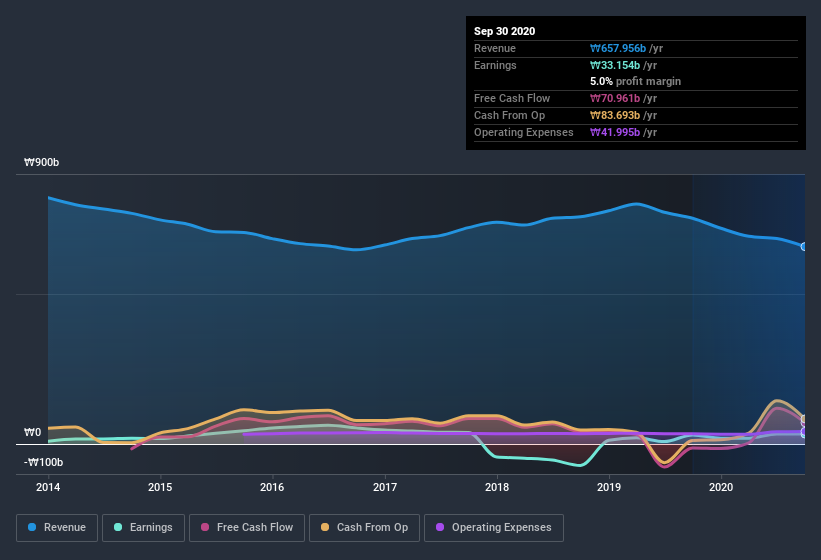- South Korea
- /
- Metals and Mining
- /
- KOSE:A104700
Should You Use KISCO's (KRX:104700) Statutory Earnings To Analyse It?
Broadly speaking, profitable businesses are less risky than unprofitable ones. Having said that, sometimes statutory profit levels are not a good guide to ongoing profitability, because some short term one-off factor has impacted profit levels. Today we'll focus on whether this year's statutory profits are a good guide to understanding KISCO (KRX:104700).
We like the fact that KISCO made a profit of ₩33.2b on its revenue of ₩658.0b, in the last year.
See our latest analysis for KISCO

Of course, when it comes to statutory profit, the devil is often in the detail, and we can get a better sense for a company by diving deeper into the financial statements. Today, we'll discuss KISCO's free cashflow relative to its earnings, and consider what that tells us about the company. Note: we always recommend investors check balance sheet strength. Click here to be taken to our balance sheet analysis of KISCO.
Zooming In On KISCO's Earnings
Many investors haven't heard of the accrual ratio from cashflow, but it is actually a useful measure of how well a company's profit is backed up by free cash flow (FCF) during a given period. In plain english, this ratio subtracts FCF from net profit, and divides that number by the company's average operating assets over that period. The ratio shows us how much a company's profit exceeds its FCF.
Therefore, it's actually considered a good thing when a company has a negative accrual ratio, but a bad thing if its accrual ratio is positive. While it's not a problem to have a positive accrual ratio, indicating a certain level of non-cash profits, a high accrual ratio is arguably a bad thing, because it indicates paper profits are not matched by cash flow. Notably, there is some academic evidence that suggests that a high accrual ratio is a bad sign for near-term profits, generally speaking.
KISCO has an accrual ratio of -0.11 for the year to September 2020. That indicates that its free cash flow was a fair bit more than its statutory profit. To wit, it produced free cash flow of ₩71b during the period, dwarfing its reported profit of ₩33.2b. Given that KISCO had negative free cash flow in the prior corresponding period, the trailing twelve month resul of ₩71b would seem to be a step in the right direction.
Our Take On KISCO's Profit Performance
As we discussed above, KISCO has perfectly satisfactory free cash flow relative to profit. Because of this, we think KISCO's earnings potential is at least as good as it seems, and maybe even better! And the EPS is up 10% over the last twelve months. Of course, we've only just scratched the surface when it comes to analysing its earnings; one could also consider margins, forecast growth, and return on investment, among other factors. Keep in mind, when it comes to analysing a stock it's worth noting the risks involved. Our analysis shows 2 warning signs for KISCO (1 is significant!) and we strongly recommend you look at them before investing.
Today we've zoomed in on a single data point to better understand the nature of KISCO's profit. But there is always more to discover if you are capable of focussing your mind on minutiae. Some people consider a high return on equity to be a good sign of a quality business. While it might take a little research on your behalf, you may find this free collection of companies boasting high return on equity, or this list of stocks that insiders are buying to be useful.
If you decide to trade KISCO, use the lowest-cost* platform that is rated #1 Overall by Barron’s, Interactive Brokers. Trade stocks, options, futures, forex, bonds and funds on 135 markets, all from a single integrated account. Promoted
Valuation is complex, but we're here to simplify it.
Discover if KISCO might be undervalued or overvalued with our detailed analysis, featuring fair value estimates, potential risks, dividends, insider trades, and its financial condition.
Access Free AnalysisThis article by Simply Wall St is general in nature. It does not constitute a recommendation to buy or sell any stock, and does not take account of your objectives, or your financial situation. We aim to bring you long-term focused analysis driven by fundamental data. Note that our analysis may not factor in the latest price-sensitive company announcements or qualitative material. Simply Wall St has no position in any stocks mentioned.
*Interactive Brokers Rated Lowest Cost Broker by StockBrokers.com Annual Online Review 2020
Have feedback on this article? Concerned about the content? Get in touch with us directly. Alternatively, email editorial-team@simplywallst.com.
About KOSE:A104700
Flawless balance sheet with moderate growth potential.
Market Insights
Community Narratives



